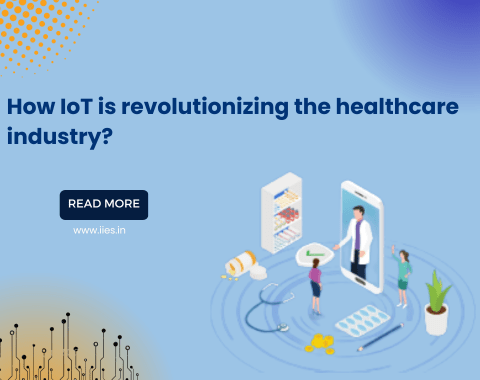
The healthcare industry is undergoing a profound transformation, thanks to the integration of cutting-edge technologies. One such technology making waves is the Internet of Things (IoT). In this blog, we will explore the role of IoT in healthcare, understanding its definition, significance, and the purpose of this exploration. IoT in healthcare refers to the network of interconnected medical devices, sensors, and systems that collect and exchange data.
This data is leveraged to monitor patient health, streamline medical processes, and improve overall healthcare delivery. IoT is reshaping the healthcare landscape by offering real-time insights, enhancing patient care, and optimizing resource utilization. It is revolutionizing how healthcare providers diagnose, treat, and monitor patients.
This blog aims to provide a comprehensive overview of IoT in healthcare, from its fundamental concepts to its transformative impact. We will delve into IoT applications, benefits, challenges, case studies, future trends, and the ethical considerations surrounding its implementation.
At its core, IoT is a network of physical objects, devices, vehicles, and other items that are embedded with sensors, software, and connectivity. These components allow them to collect and exchange data over the internet.
In healthcare, IoT extends this concept to medical devices and equipment. It enables the seamless flow of data, facilitating remote monitoring, data analytics, and real-time decision-making.
Sensors and Devices: These are the frontline data gatherers, measuring vital signs, patient activity, and more.
Connectivity: Robust internet connectivity is essential to transmit data securely and in real time.
Data Analytics and Cloud Computing: These components process and store vast amounts of healthcare data, providing actionable insights.
Real-time Vital Signs Tracking: IoT devices continuously monitor patients’ vital signs, providing instant alerts in case of anomalies.
Chronic Disease Management: Patients with chronic conditions benefit from continuous monitoring, reducing hospital visits, and improving quality of life.
Fitness Trackers and Health Monitoring Devices: Wearables like smartwatches and fitness bands help individuals track their health and fitness goals.
Wearable ECG Monitors: These devices offer on-the-go heart monitoring, benefiting individuals with cardiac issues.
Tracking Medical Equipment: IoT tags and sensors help hospitals keep track of medical equipment, preventing loss and ensuring timely maintenance.
Inventory Management: Automated inventory tracking reduces waste, enhances resource allocation, and ensures critical supplies are always available.
Expanding Access to Healthcare: IoT enables remote consultations, breaking down geographical barriers to healthcare access.
Reducing Healthcare Costs: Telemedicine reduces travel and associated costs, making healthcare more affordable.
Smart Pill Dispensers: These devices dispense medication at prescribed times and send reminders to patients.
Medication Reminders: IoT solutions remind patients to take their medication, improving adherence rates and treatment outcomes.
Timely Interventions: Real-time data alerts healthcare providers to changes in patient health, enabling immediate interventions.
Enhanced Diagnostic Capabilities: IoT data aids in quicker and more accurate diagnoses.
Streamlined Workflows: IoT automates routine tasks, reducing administrative burdens on healthcare staff.
Resource Optimization: Efficient resource allocation, driven by IoT insights, reduces waste and saves costs.
Lower Hospital Readmission Rates: Remote monitoring and early intervention help prevent complications, reducing hospital readmissions.
Reduced Healthcare Expenses: IoT-driven efficiencies translate to cost savings for healthcare institutions and patients.
Predictive Analytics: IoT data enables predictive analytics to forecast disease outbreaks and patient needs.
Personalized Treatment Plans: Tailored treatment plans based on patient data lead to better outcomes.
Protecting Patient Information: Safeguarding patient data from breaches is paramount.
Compliance with Regulations (e.g., HIPAA): Healthcare IoT must adhere to strict privacy regulations.
Ensuring Seamless Connectivity: Devices and systems from different manufacturers should seamlessly communicate.
Compatibility Issues: Lack of interoperability can hinder the adoption and effectiveness of IoT in healthcare.
Ensuring Sensor Accuracy: Inaccurate data from IoT devices can lead to incorrect diagnoses or treatment.
Mitigating False Alarms: False alarms can cause unnecessary stress for patients and healthcare providers.
Philips Healthcare and Their IoT Solutions: Philips leverages IoT for patient monitoring, sleep apnea therapy, and more.
IoT-Enabled Patient Monitoring at Mayo Clinic: Mayo Clinic utilizes IoT to remotely monitor patients and reduce hospital stays.
IoT-Based Telemedicine Platforms like Teladoc: Telemedicine platforms like Teladoc connect patients with healthcare professionals, offering convenience and accessibility.
The integration of AI and machine learning with IoT will enable more advanced predictive analytics, personalization of treatment plans, and smarter decision-making.
Edge computing brings processing closer to data sources, reducing latency and enhancing real-time analytics for critical medical applications.
The rollout of 5G networks will enhance connectivity, making real-time remote monitoring and telemedicine even more efficient and accessible.
As IoT becomes more deeply integrated into healthcare, ethical considerations related to data privacy, consent, and responsible AI usage will become increasingly critical.
In conclusion, IoT is a game-changer in the healthcare industry. Its applications are diverse, ranging from remote patient monitoring to smart wearables and telemedicine. The benefits are equally impressive, from improved patient care to cost reduction and data-driven insights. However, challenges such as data security, interoperability, and accuracy must be addressed.
As we look to the future, the integration of AI, edge computing, 5G, and ethical considerations will shape the trajectory of healthcare IoT. The potential for further growth in this field is immense, and healthcare providers are encouraged to embrace IoT technologies
Indian Institute of Embedded Systems – IIES